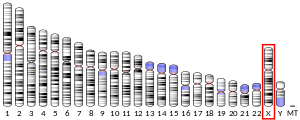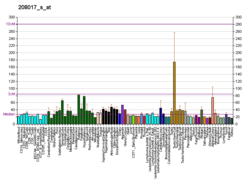MCF2
The DBL proto-oncogene is a protein that in humans is encoded by the MCF2 gene.[5][6][7]
The commonly-used name DBL is derived from “diffuse B-cell lymphoma”, the cancer type where this gene was first identified as an oncogene,[8] while the name MCF2 name derives from “MCF.2 cell line-derived transforming sequence”.[9]
DBL is the founding member of a large family of guanine nucleotide exchange factors that share a common DBL-homology (DH) domain), so DBL is also named as a member of this RhoGEF family as ARHGEF21. DH domains function to activate small GTPases of the Rho family by facilitating release of GDP from an inactive Rho GTPase and binding of GTP to activate it. In particular, DBL activates the Rho family member Cdc42.[10]
Gene recombinations that result in the loss of N-terminal regions produce MCF2 variants with oncogenic activity.[supplied by OMIM][7]
References
- GRCh38: Ensembl release 89: ENSG00000101977 - Ensembl, May 2017
- GRCm38: Ensembl release 89: ENSMUSG00000031139 - Ensembl, May 2017
- "Human PubMed Reference:". National Center for Biotechnology Information, U.S. National Library of Medicine.
- "Mouse PubMed Reference:". National Center for Biotechnology Information, U.S. National Library of Medicine.
- Noguchi T, Galland F, Batoz M, Mattei MG, Birnbaum D (December 1988). "Activation of a mcf.2 oncogene by deletion of amino-terminal coding sequences". Oncogene. 3 (6): 709–15. PMID 2577874.
- Galland F, Stefanova M, Lafage M, Birnbaum D (Jul 1992). "Localization of the 5' end of the MCF2 oncogene to human chromosome 15q15----q23". Cytogenetics and Cell Genetics. 60 (2): 114–6. doi:10.1159/000133316. PMID 1611909.
- "Entrez Gene: MCF2 MCF.2 cell line derived transforming sequence".
- Eva A, Aaronson SA (1985-07-18). "Isolation of a new human oncogene from a diffuse B-cell lymphoma". Nature. 316 (6025): 273–5. doi:10.1038/316273a0. PMID 3875039.
- Noguchi T, Mattei MG, Oberlè I, Planche J, Imbert J, Pelassy C, et al. (May 1987). "Localization of the mcf.2 transforming sequence to the X chromosome". The EMBO Journal. 6 (5): 1301–7. doi:10.1002/j.1460-2075.1987.tb02368.x. PMC 553933. PMID 3038515.
- Fort P, Blangy A (June 2017). "The Evolutionary Landscape of Dbl-Like RhoGEF Families: Adapting Eukaryotic Cells to Environmental Signals". Genome Biology and Evolution. 9 (6): 1471–1486. doi:10.1093/gbe/evx100. PMC 5499878. PMID 28541439.
Further reading
- Ron D, Zannini M, Lewis M, Wickner RB, Hunt LT, Graziani G, et al. (April 1991). "A region of proto-dbl essential for its transforming activity shows sequence similarity to a yeast cell cycle gene, CDC24, and the human breakpoint cluster gene, bcr". The New Biologist. 3 (4): 372–9. PMID 2065022.
- Tronick SR, McBride OW, Popescu NC, Eva A (October 1989). "Chromosomal localization of DBL oncogene sequences" (Submitted manuscript). Genomics. 5 (3): 546–53. doi:10.1016/0888-7543(89)90022-0. PMID 2613238.
- Ron D, Tronick SR, Aaronson SA, Eva A (August 1988). "Molecular cloning and characterization of the human dbl proto-oncogene: evidence that its overexpression is sufficient to transform NIH/3T3 cells". The EMBO Journal. 7 (8): 2465–73. PMC 457116. PMID 3056717.
- Eva A, Vecchio G, Rao CD, Tronick SR, Aaronson SA (April 1988). "The predicted DBL oncogene product defines a distinct class of transforming proteins". Proceedings of the National Academy of Sciences of the United States of America. 85 (7): 2061–5. doi:10.1073/pnas.85.7.2061. PMC 279928. PMID 3281159.
- Srivastava SK, Wheelock RH, Aaronson SA, Eva A (December 1986). "Identification of the protein encoded by the human diffuse B-cell lymphoma (dbl) oncogene". Proceedings of the National Academy of Sciences of the United States of America. 83 (23): 8868–72. doi:10.1073/pnas.83.23.8868. PMC 387034. PMID 3491366.
- Hart MJ, Eva A, Zangrilli D, Aaronson SA, Evans T, Cerione RA, Zheng Y (January 1994). "Cellular transformation and guanine nucleotide exchange activity are catalyzed by a common domain on the dbl oncogene product". The Journal of Biological Chemistry. 269 (1): 62–5. PMID 8276860.
- Nishida K, Kaziro Y, Satoh T (October 1999). "Association of the proto-oncogene product dbl with G protein betagamma subunits". FEBS Letters. 459 (2): 186–90. doi:10.1016/S0014-5793(99)01244-2. PMID 10518015.
- Kato J, Kaziro Y, Satoh T (February 2000). "Activation of the guanine nucleotide exchange factor Dbl following ACK1-dependent tyrosine phosphorylation". Biochemical and Biophysical Research Communications. 268 (1): 141–7. doi:10.1006/bbrc.2000.2106. PMID 10652228.
- Zhu K, Debreceni B, Li R, Zheng Y (August 2000). "Identification of Rho GTPase-dependent sites in the Dbl homology domain of oncogenic Dbl that are required for transformation". The Journal of Biological Chemistry. 275 (34): 25993–6001. doi:10.1074/jbc.M003780200. PMID 10854437.
- Palmieri G, de Franciscis V, Casamassimi A, Romano G, Torino A, Pingitore P, et al. (July 2000). "Human dbl proto-oncogene in 85 kb of xq26, and determination of the transcription initiation site". Gene. 253 (1): 107–15. doi:10.1016/S0378-1119(00)00212-2. PMID 10925207.
- Jin S, Exton JH (November 2000). "Activation of RhoA by association of Galpha(13) with Dbl". Biochemical and Biophysical Research Communications. 277 (3): 718–21. doi:10.1006/bbrc.2000.3744. PMID 11062019.
- Zhu K, Debreceni B, Bi F, Zheng Y (January 2001). "Oligomerization of DH domain is essential for Dbl-induced transformation". Molecular and Cellular Biology. 21 (2): 425–37. doi:10.1128/MCB.21.2.425-437.2001. PMC 86589. PMID 11134331.
- Vanni C, Mancini P, Gao Y, Ottaviano C, Guo F, Salani B, et al. (May 2002). "Regulation of proto-Dbl by intracellular membrane targeting and protein stability". The Journal of Biological Chemistry. 277 (22): 19745–53. doi:10.1074/jbc.M111025200. PMID 11907027.
- Wennerberg K, Ellerbroek SM, Liu RY, Karnoub AE, Burridge K, Der CJ (December 2002). "RhoG signals in parallel with Rac1 and Cdc42". The Journal of Biological Chemistry. 277 (49): 47810–7. doi:10.1074/jbc.M203816200. PMID 12376551.
- Komai K, Okayama R, Kitagawa M, Yagi H, Chihara K, Shiozawa S (December 2002). "Alternative splicing variants of the human DBL (MCF-2) proto-oncogene". Biochemical and Biophysical Research Communications. 299 (3): 455–8. doi:10.1016/S0006-291X(02)02645-1. PMID 12445822.
- Komai K, Mukae-Sakairi N, Kitagawa M, Shiozawa S (October 2003). "Characterization of novel splicing variants of the mouse MCF-2 (DBL) proto-oncogene". Biochemical and Biophysical Research Communications. 309 (4): 906–9. doi:10.1016/j.bbrc.2003.08.088. PMID 13679059.
- Kimura K, Wakamatsu A, Suzuki Y, Ota T, Nishikawa T, Yamashita R, et al. (January 2006). "Diversification of transcriptional modulation: large-scale identification and characterization of putative alternative promoters of human genes". Genome Research. 16 (1): 55–65. doi:10.1101/gr.4039406. PMC 1356129. PMID 16344560.





